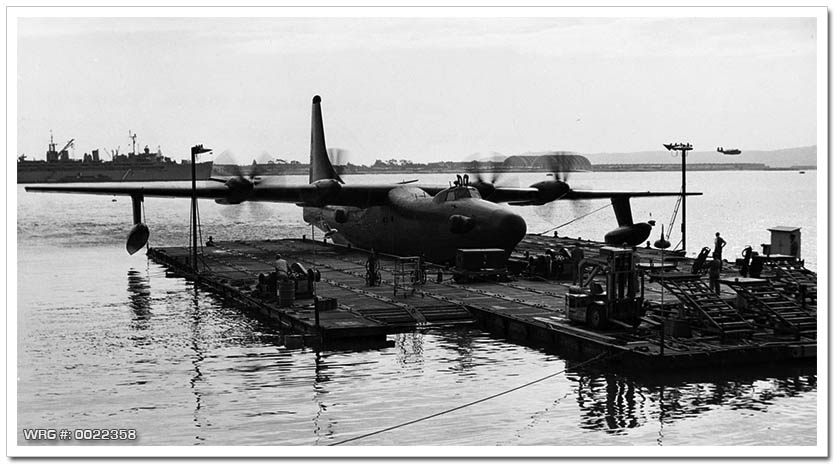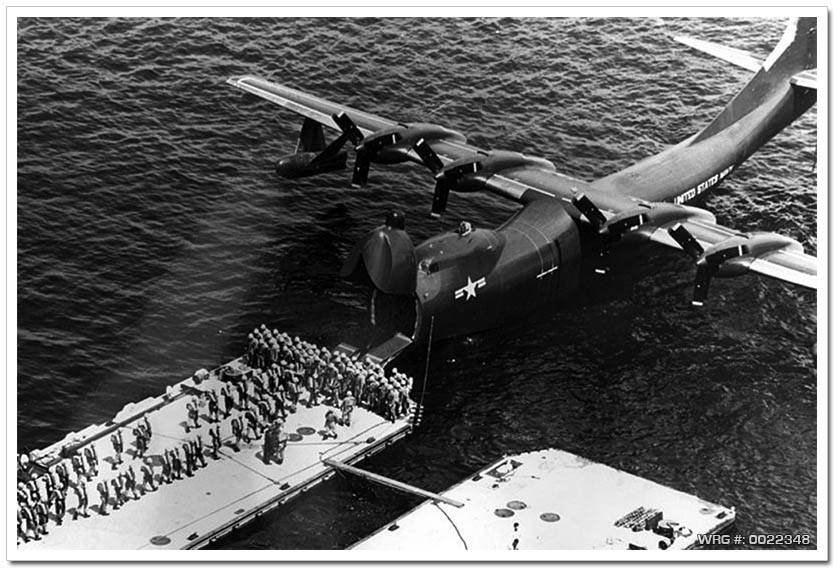U.S. NAVAL AVIATION RESOURCE CENTER > FLYING BOATS > TRADEWIND > PREVIOUS PAGE
CONVAIR R3Y TRADEWIND
Design & Development
Convair received a request from the United States Navy in 1945 for the design of a large flying boat using new technology developed during World War II, especially the laminar flow wing and still-developing turboprop technology. Their response was the Model 117. It was a large high-wing flying boat with Allison T-40 engines driving six-bladed contra-rotating propellers. It had a sleek body with a single-step hull and a slender high-lift wing with fixed floats. The Navy ordered two prototypes on May 27, 1946. Designated XP5Y-1, the first aircraft first flew on 18 April 1950 at San Diego. In August the aircraft set a turboprop endurance record of eight hours six minutes. The Navy decided not to proceed with the patrol boat version, instead directing that the design should be developed into a passenger and cargo aircraft.

Convair XP5Y-1 Tradewind docks on April 18, 1950 at San Diego, CA.
[Source: U.S. Navy]
One of the XP5Y-1 prototypes was lost in a non-fatal accident on July 15, 1953, while design and development continued on the passenger and cargo version of the aircraft. The transport and cargo version was designated the R3Y-1 Tradewind and first flew on February 25, 1954. Major changes were the removal of all armament and of the tailplane dihederal, the addition of a 10 ft (3.05 m) port-side access hatch, and redesigned engine nacelles to accept improved T40-A-10 engines. Cabin soundproofing and airconditioning were added for pressurised accommodation for 103 passengers or 24 tons of cargo. As a medevac aircraft, 92 stretcher cases could be carried.
A total of eleven aircraft were built. The first two prototypes built were in P5Y configuration, armed with 8,000 lb (3,600 kg) of munitions (bombs, mines, depth charges, torpedoes) and five pairs of 20 mm cannon in fore and aft side emplacements and a tail turret. The next five were built as R3Y-1 aircraft, intended for troop transport and inflight refuelling tanker service. The final six were built as the R3Y-2 variant with a lifting nose and high cockpit (similar in concept to the C-5 Galaxy's nose and cockpit) for heavier transport and landing-ship duties.

A Convair R3Y Tradewind loading/unloading troops.
[Source: U.S. Navy via Mark Allen Collection]
The front-loading R3Y-2 aircraft with a hinged nose and high cockpit were intended to be a Flying LST (landing craft). In practice, it was discovered that it was almost impossible for the pilots to hold the aircraft steady and nose on to the beach while the aircraft was loaded or unloaded. The aircraft were converted into tankers for the inflight refuelling role. They had a short service life because of the unsolvable unreliability problems of their Allison T40 turboprop engines.
Source:
Wikipedia
U.S. NAVAL AVIATION RESOURCE CENTER > FLYING BOATS > TRADEWIND > PREVIOUS PAGE


